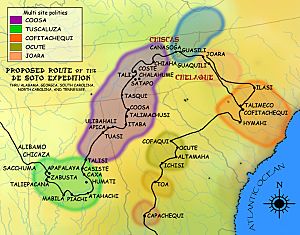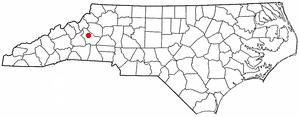Joara facts for kids
Joara was a large Native American settlement. It was a powerful regional center of the Mississippian culture. You can find its remains in what is now Burke County, North Carolina. This spot is about 300 miles from the Atlantic coast, nestled in the foothills of the Blue Ridge Mountains. Joara is super important for archaeologists and historians. They have found amazing artifacts from both the Mississippian culture and early European explorers here. There's also an old earthwork platform mound and parts of a Spanish fort from the 1500s.
The first Europeans arrived in the mid-1500s. In 1540, the Spanish explorer Hernando De Soto and his group visited Joara. Later, in 1567, another Spanish explorer named Juan Pardo came. He built Fort San Juan right here. This was the first European settlement deep inside the continent! Pardo also built other forts further west. He hoped to create a path to silver mines in Mexico. The Spanish mistakenly thought the Appalachian Mountains were the same as mountains in central Mexico. About 18 months later, almost all the Spanish soldiers in these six forts were killed by the local Native Americans. Pardo had already left and survived. The Spanish never tried to settle this area again. British settlers didn't arrive until the late 1700s.
In the late 1900s, a Spanish story about Pardo's trip was found and translated. Because of this, archaeologists started digging in Burke County in the 1990s. In 2008, they found both European and Mississippian artifacts. Then, on July 22, 2013, archaeologists announced they had found proof of Fort San Juan at Joara. This included a moat that cut through an earthwork mound built by the Mississippians.
Contents
Joara's Early History and Spanish Arrival
Archaeological discoveries in the 2000s have shown that Joara was a big Mississippian settlement. It also had a short visit from the Spanish in the 1500s. The Joara chiefdom was where Fort San Juan was built. This was the very first Spanish outpost in what is now North Carolina, from 1567 to 1568. This happened 40 years before the English settled at Jamestown. It was also almost 20 years before their "Lost Colony" at Roanoke Island.
The Joara site is northwest of Morganton. Archaeologists have been digging here since the early 2000s. They often hold open houses and educational events for the public during the summer digging season.
Life at Joara Before Europeans Arrived
Joara was started around the year 1000 AD. It became the largest Mississippian culture settlement in North Carolina. The Mississippian culture built large earthwork mounds. Joara was built on the west bank of Upper Creek, with a view of Table Rock. This was the eastern edge of the larger Mississippian culture, which was mostly in the Mississippi and Ohio river valleys.
When the Spanish first met Native Americans in the southern Appalachians, Joara was already the biggest Mississippian settlement in North Carolina. It was the main political center for many smaller native towns nearby. Most experts today believe that "Joara" is connected to the Cheraw people. They spoke a Siouan language and lived in this area later on.
First European Contact: Hernando de Soto
In 1540, Hernando de Soto led a Spanish army through parts of Georgia, South Carolina, and North Carolina. This was the first time Europeans met the people of Joara. De Soto's writers called the town "Xuala." De Soto brought the queen of Cofitachequi province to Joara. She was not there by choice. The writers said the queen also ruled over Joara and the "Chalaque" people. Many believe "Chalaque" refers to the Cherokee. The queen managed to escape from the Spanish after they reached Joara.
The Spanish then left Joara. They crossed the Blue Ridge Mountains into what is now eastern Tennessee. They visited the Coosa chiefdom, which they called "Guasile." The Creek people are thought to be descendants of the Coosa.

Juan Pardo's First Expedition and Fort San Juan
On December 1, 1566, Spanish Captain Juan Pardo and 125 soldiers left Santa Elena. This was a Spanish base on Parris Island, South Carolina. Pardo's orders were to claim the land for Spain. He also had to make friends with the natives and convert them to Catholicism. He also needed to find a route to Spanish silver mines in Zacatecas, Mexico. The Spanish thought Santa Elena was much closer to the mines than it really was. They also confused the Appalachian Mountains with mountains in central Mexico.
To find food, the Spanish traveled northwest from the coast. They stopped at places like Otari (near Charlotte) and Yssa (near Denver). They finally reached Joara in January 1567.
Captain Pardo renamed Joara "Cuenca," after his hometown in Spain. Snow in the mountains forced them to stay for the winter. The explorers built a wooden fort at the north end of Joara. They named it Fort San Juan. This fort was the first European settlement in North Carolina. It was built 18 years before the English colony at Roanoke Island. It was also 40 years before Jamestown, Virginia.
The Spanish kept soldiers at Fort San Juan. They also claimed control over other towns nearby. In February 1567, Captain Pardo built Fort Santiago at Guatari. This was a smaller town of Wateree natives.
Pardo heard that French forces might attack Santa Elena. So, he left 30 soldiers at Fort San Juan. He also left four soldiers and a priest at Guatari. Pardo then left the area with the rest of his men. He put Sergeant Hernando Moyano in charge of Fort San Juan.
Hernando Moyano's Raids
In the spring of 1567, Hernando Moyano led Spanish soldiers and Native Americans north. They attacked and burned the Chisca tribe's village of Maniateque. Then they returned to Joara. After resting, Moyano led his men to Guapere. They attacked and burned Guapere. Then they marched west to Chiaha. Moyano's group built a fort in Chiaha and waited for Captain Pardo to return.
Juan Pardo's Second Expedition and the Uprising
Captain Juan Pardo returned to Fort San Juan in September 1567. He found the local people angry. The Spanish had demanded food, women, and canoes. Also, new diseases from the Europeans were making many natives sick and causing deaths. This made the natives resent the Spanish. Instead of going to Mexico, Pardo left soldiers at Fort San Juan. He then marched west to help Moyano's troops.
Pardo first took his troops to Tocae, then to Cauchi, and Tanasqui. Finally, they reached Chiaha, where Moyano's troops needed supplies. After helping them, Pardo went back to Santa Elena.
Soon after May 1568, news reached Santa Elena. The native people had burned all six Spanish forts built by Juan Pardo. They killed all but one of the 120 Spanish soldiers. Pardo never came back to the area. Spain stopped trying to settle the interior of the Southeast.
Pardo's story of his travels was found in the 1980s and translated. This, along with the archaeological finds at Joara, has changed how we understand Spanish colonization in North America.
Why Joara Was Abandoned
When the Spanish first arrived, Native American groups were known by their villages. They were part of larger regional cultures. Many smaller groups disappeared because of European diseases. Also, larger tribes like the Catawba and Cherokee took over or mixed with them.
By the time English, Scots-Irish, and German settlers arrived in the late 1700s, Joara and many other old native towns were empty. The sites became overgrown, and the remains were hidden. However, further west in North Carolina and Tennessee, the Cherokee continued to live in many Mississippian culture towns.
Even though Joara and Fort San Juan were forgotten, local people found many native artifacts. In the early 1950s, farmers even bulldozed Joara's 12-foot-high earth mound to make way for farming. Now, the mound is only a small two-foot rise in the field. But the current owners promise to protect the site.
Finding Joara Again: The Berry Site
In the 1960s and 1970s, archaeologists looked for Joara and Fort San Juan in Burke County. By the 1980s, they narrowed down the possible locations and started digging. These digs showed that the upper Catawba River Valley had many native people living there from the 1300s to the 1500s.
A big discovery happened in 1986 at the Berry excavation site. This site is named after the family who owns the land. Archaeologists found Spanish artifacts from the 1500s. This evidence, along with Pardo's story, made them rethink Pardo's route. It suggested that the Berry Site was indeed Joara and Fort San Juan. This archaeological site shows how much the Spanish tried to settle the interior Southeast. The other five Spanish forts further west have not been found yet.
More digging at the Berry site in the 1990s and 2000s found remains of the native Joara settlement. They also found burned Spanish huts and more Spanish artifacts from the 1500s. These included pieces of olive jars, a spike, and a knife. In 2007, they found a Spanish iron scale and proof of Spanish building methods. These were not trade goods. They were things the Spanish used themselves. Joara is special because it shows how Native Americans and the Spanish interacted. The Spanish were few in number and relied on the natives for food.
In 2009, archaeologists agreed that this was definitely the site of Joara and Fort San Juan. The evidence supports the Spanish settlement from 1567 to 1568. It also shows that the natives burned the fort. The things found here have changed how we understand the first European contact with Native Americans. In July 2013, archaeologists reported finding parts of the fort itself. This included burned palisades and what looked like the main building inside the fort.
Curiosities
There is a small town in northern Spain also called Joara.


